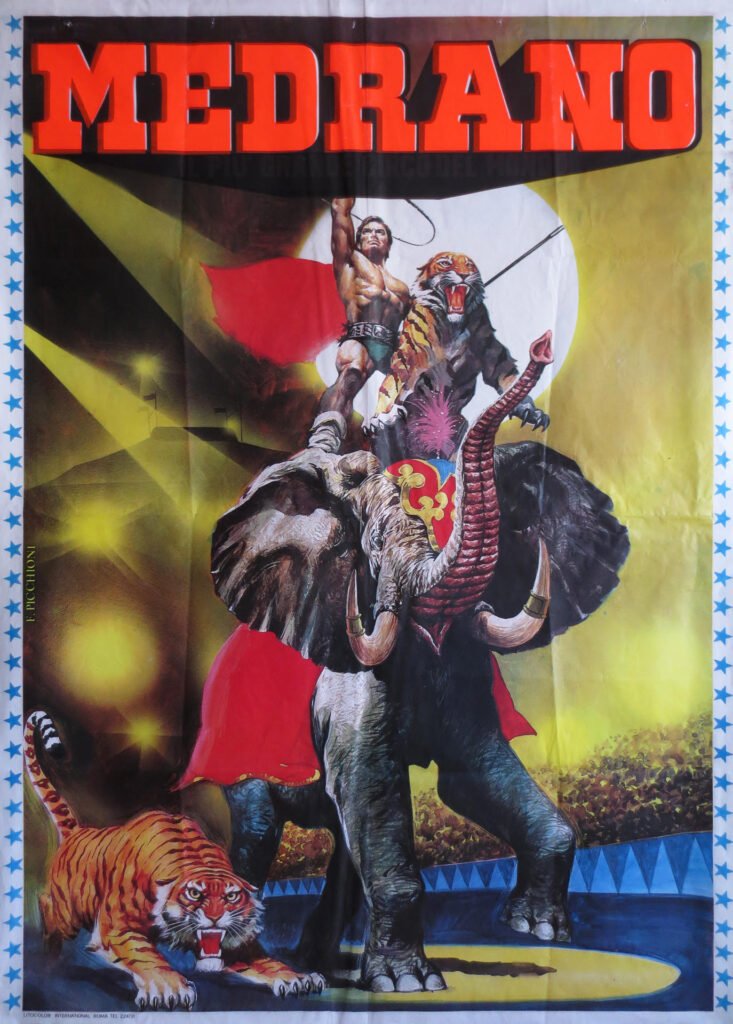This gallery features the original color version of the illustrations that appear in black & white in the book with references to the relevant pages as well as additional comments.
In the age of colour print, mass-produced circus posters not only were effective promotional tools, taking up the functions of the traditional banners, but also became a pictorial genre of its own. With various degrees of realism and fantasy, artists created epic representations of circus acts that impacted the perception, interpretation, and memory of the performances. The End of the Circus gratefully acknowledges the collaboration of www.circus-collectibles.com, a website owned and managed by its creator, Jovan Andric. The examples featured here come from this private collection of circus posters that is one of the most important in the world. Readers can appreciate the colourful original posters that were reproduced in black-and-white versions in the book.

The posters and banners of the traditional circuses and menageries enticed their audience with hyperbolic representations of wild predators, showing a single diminutive but bold human outnumbered by raging oversized carnivorous animals such as aggressive polar bears …Circo Orlando Orfei (Italy). The comment reads [in Italian]: “White bears from the North Pole: Fantastic !!!” (Courtesy of Jovan Andric). https://www.circus-collectibles.com/poster/detail/805
… or reluctant lions that are forcefully driven through their pace while the whole pride menacingly encircles the trainer armed with a mere whip. Italia stock poster from the late 1960s, Artwork by Marcello Colizzi. (Courtesy of Jovan Andric). https://www.circus-collectibles.com/poster/detail/1307

Feared predators, crocodiles are featured here being subdued by the magic power of a master who has donned the outfit of an Indian fakir. Circus Krone (Germany): poster from 1987 featuring Karah Khavac with crocodiles. Artwork by Marcello Colizzi. (Courtesy of Jovan Andric). https://www.circus-collectibles.com/ poster/detail/335


Another genre of posters represents man as the wild master of the beasts. Here, the trainer impersonates the Cossack hero of Gogol’s novella, Taras Bulba, popularized by the 1962 Hollywood movie starring Yul Brynner. It conveys the idea that one has to share the predators’ wildness in order to subdue them. Circo di Budapest TARAS BULBA—Italian circus poster from the mid-1980s featuring Emilien Beautour a.k.a. Taras Bulba, a French tiger trainer. Artwork by Aller. (Courtesy of Jovan Andric). https://www.circus-collectibles.com/poster/detail/1397

In a totally different mode, an elegant and poised trainer demonstrates his dominance by controlling a grossly oversized tiger. In spite of the unrealistic rendering of this scene, the audience will be influenced not only in their perception but also in their memory of this act. Circus Knie (Switzerland) poster from 1960 featuring the animal trainer Gilbert Houcke. Artwork by Marcus Campbell. (Courtesy of Jovan Andric). https://www.circus-collectibles.com/poster/detail/1482

Female dominance over male lions or black jaguar is a powerful icon in the traditional promotion of animal acts that suggests complicit wildness. These symbolic compositions combine raw eroticism with the dramatic staging of
a circus background. Note the leopard skin patterns of the minimal outfit of the trainers.
Circo Braums—Italian poster from 1978. (Courtesy of Jovan Andric). https:// www.circus-collectibles.com/poster/detail/1388
Circo Medrano (Italy) poster from 1974. Artwork by Renato Casaro. (Courtesy of Jovan Andric). https://www.circus-collectibles.com/poster/detail/1686

Overcoming the fear of snakes with charm and authority is a powerful image of human supremacy that is commonly displayed in the traditional circus. The comment on the poster reads (in Italian): “Miss Chantal in a mortal hug with giant python, boa constrictor, and anaconda.” Crazy Cobra Show—Italian poster from 1997 featuring Miss Chantal, snake charmer. (Courtesy of Jovan Andric). https://www. circus-collectibles.com/poster/detail/418

The precondition for the emergence of civilization is the effective control of predators that are more powerful than humans. These images illustrate the mastering of the wild through skill and courage, and celebrate the triumph of the wild animal trainer as a cultural hero. Circo Rinaldo Orfei. Italian poster from 1978. (Courtesy of Jovan Andric). https://www.circus-collectibles.com/poster/detail/621

The ultimate triumph of the manly hero riding the wildest of animals. Such representations feed the symbolic capital of the imaginary circus by embodying the victory over the erstwhile challenge of predators. This image extracts from
a relatively common act with tame animals the ritualistic significance of the performance it advertises. Circo Medrano (Italy) poster from the mid-1980s promoting Davio Casartelli’s tiger and elephant act. Artwork by Franco Picchioni. (Courtesy of Jovan Andric). https://www.circus-collectibles.com/poster/detail/997




Photo credit: Serge Fleury

164 The literary and visual trope of the clown as Christ’s figure is well established and undoubtedly inspired the artist who represented the demise of the McDonald’s iconic logo through the symbol of the crucifixion. The sufferings of the clown, construed as redemption for humanity as a mystic representation of Christ, is present for instance in the paintings of the French expressionist George Rouault (1871-1958). This theme is implicitly recurrent in Symbolist poetry and literary works such as Henry Miller’s The Smile at the Foot of the Ladder (New York: Duell, Sloane & Pearce, 1948). A very explicit articulation of this figure is found in a Christian website with the tag “Christ as Clown”[ https://artandtheology.org ] or in “Christ as Clown Theory” propounded by Harvey Cox in The Feast of Fools (Harvard University Press, 1969).
“McJesus” 2015. By Jani Leinonen. Photo credit: Vilhelm Sjöström. Published with the kind permission of the artist and the Zetterberg Gallery, Helsinki.